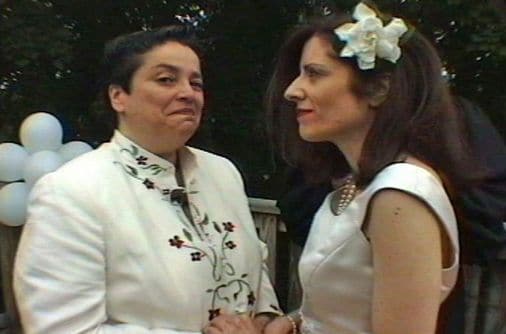Eye For Film >> Movies >> Blindsided (2015) Film Review
Blindsided
Reviewed by: Jennie Kermode

What does it mean to be an artist? When she came to the attention of documentarian Lisa Olivieri, Patricia Livingstone was losing both her sight and her hearing. She was trying to finish a painting - to know that she could achieve this one thing, to make the rest bearable. This was an intriguing situation in itself, but as she got to know her subject, Olivieri realised that there was much, much more to her story.
Patricia is one of the most persistently creative people one could meet. Her home, where most of the footage here was shot, is a testament to that, and throughout the film she's innovating, find ways to work around her impairments and coming up with new ideas. It would be difficult to make a dull film about her. Although we see the serious impact that her impairments have on her life, and the difficult psychological journey she must undertake as she adjust to them, they're far from the only things that make her work interesting.
Like many people dealing with progressive impairment, Patricia becomes increasingly dependent on her partner, Karen. This experience inevitably puts strain on a relationship and in this case things get very difficult indeed. It was quite some time after filming had commenced that Olivieri learned that Patricia had become a victim of domestic abuse. She reconstructs the story of the relationship using footage from the couple's home videos, from happy beginnings when they're all smiles and laughter, through a period when Patricia seems awkward and withdrawn and every conversation turns into an argument, through to a point where they are living together as friends and trying to put past tensions behind them. Karen talks to camera about the abuse, not taking full responsibility but discussing it in a matter of fact manner and discussing her concern that Patricia, who is just embarking on another relationship, could find herself in the same situation again.
To say more would be to give too much away. Suffice to say that Olivieri continues to follow Patricia for several more years until she's at a very different stage in her life. The film has a powerful message about how it's possible to escape from abusive situations (even when faced with multiple additional disadvantages). It's also important as an acknowledgement that women can be abusers and that abuse does happen within same sex relationships, something that has often been denied in an effort to resist homophobia. It's very rare for abusers themselves to be part of public conversations about abuse and although this has made some people uncomfortable abut the film, there's no effort made to absolve Karen - she speaks on her own terms and provides insight, not least into her own psychology. Her recognition that her behaviour was damaging and regret over the increasing distance between her and Patricia may send important messages to people who are concerned about their own behaviour.
With much of the film shot on home movie cameras, the quality here isn't high, but that's the trade-off for an extraordinary level of intimacy. Very little seems to have been held back. The vast amount of archive footage supports almost 20 years of story, and that's not counting the snapshots that take us back to Patricia's childhood, with reference to what was expected of disabled people's lives at the time. Olivieri doesn't go into the medical aspects of the story in depth - they're beside the point, really, and they might distract viewers from recognising Patricia as a person - but we do see her investigating Cochlear implant surgery, very sure of what she wants. Whilst this surgery is controversial within the Deaf community, Patricia has no such community around her and would, at any rate, be unable to communicate through signing or text because of her visual impairment. We see her working hard to learn Braille and tactile signing but the latter is, at least in these early stages, slow and frustrating for her.
Much more than just a story of survival, this is a portrait of a unique and complex individual who is forever reinventing herself and finding new ways to engage with the world around her. Where it addresses disability, it does so without projecting ableist ideas onto its subject, without diminishing her. It makes room for her sexuality, something that disabled people are often expected to set aside as if it were a luxury, and likewise her fierce sense of humour. As such, rather than making her look like a natural victim, it emphasises that domestic abuse is something that can happen to anyone. Above all, it's a reminder that no matter how striking one aspect of a person might be, it's never the whole picture.
Reviewed on: 22 Oct 2020















